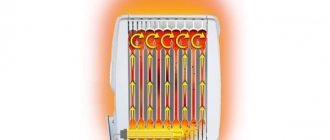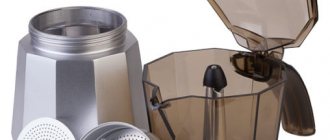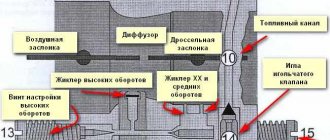The use of gasoline scythes is due to the need to treat home or garden areas and open areas. During use, the lawn mower, and in particular its mechanical components, is subject to a large load from internal and external factors. In order for the tool to work as efficiently as possible from the very beginning of purchase, and not break down for a long time, it is necessary to run in the gasoline lawn mower before using it. This is performed under stationary conditions by a trained specialist or by the owner of the product themselves, since there are no complex operations in the process. The main thing is to know how to properly break in a gas-powered tool so as not to cause errors. You can also address this question to specialists who sell you a new, untested scythe, or who carry out major repairs to replace drive units.
When explaining whether your lawn mower needs a break-in, we will highlight the advantages of such an event:
- The new tool is evenly lubricated;
- Grinding in of all parts is carried out;
- The product smoothly goes into operating mode;
- A comfortable examination of the instrument is carried out in case of identifying the need to regulate the interaction of mechanisms to stabilize work processes.
The last point also allows you to check the quality of engine operation during run-in after a major overhaul, when smooth commissioning also takes place. In a similar way, they also perform a break-in after the spare parts for the brush cutter have been changed in the engine, gearbox and other mechanisms.
Peculiarities
It should be noted that the gasoline scythe is very easy to operate. It is enough to see how other users use this unit to start using it fully. Performing basic technical functions is intuitive and does not require any difficulties in practice. Properly running in a gasoline trimmer is also not difficult. Moreover, there is almost no difference between devices of the household and professional categories.
The key difference is the type of motor. On professional equipment it is more powerful and produces more revolutions. The two-stroke engine is more often used in household models. Four-stroke units are more reliable and produce more force, so they are suitable for special conditions, complex and overgrown areas.
In addition, you need to consider whether the delivery kit includes a cutting device.
Running in a gasoline trimmer
In most cases, running-in is used in a brush cutter ( gasoline
). Running in involves operating the engine at low speeds, without loads. To run it in, you need to start the lawn mower and let it run at idle speed. It is best to do the first mowing with a fishing line, because when mowing lawn grass, the load on the engine is less high than when working with hay or shrubs.
It is not necessary to use up the entire temporary resource when starting the engine for the first time. It is best to mow the lawn for 10-15 minutes after idling, then turn off the machine and let it cool slightly. You should use the brush cutter carefully, without sudden movements, to avoid collisions with hard objects (stones). Hitting a stone can have a bad effect on the operation of components that have not yet been broken in. In some cases, backlash, noise and rumble occur during operation. This can simply be avoided if you properly break in the trimmer .
Pre-launch preparations
So, let's start with preparing for work. How to bring a lawn mower to a state of complete readiness for use?
First of all, assemble it if it is disassembled. Securely secure the detachable rod in the latches. Carefully check the fixation of the cutting equipment, especially if it is a knife or saw blade. Gasoline trimmers are generally extremely powerful and the rotation speed of the cutting attachment is fantastic. Therefore, a poorly secured blade, firstly, can injure the worker, and, secondly, causes additional vibration in the tool, which can lead to its breakage.
Gasoline models are most often equipped with a two-stroke engine, so they require the preparation of a fuel mixture. What is its purpose? Since such engines do not have a crankcase or a separate system for oil lubrication, this role is performed directly by the combustible mixture.
It is prepared in certain proportions and for one filling. You should not immediately dilute several liters with a “reserve”, since the composition must always be fresh.
Store fuel in the gas tank for more than one week
When storing the prepared fuel mixture for more than one week, the oil with additives loses its properties and does not provide high-quality piston lubrication. It is necessary to stir the mixture only in the amount necessary for work. If fuel residue remains in the tank, it will need to be removed. It is recommended to take prepared combustible fuel using a medical syringe. This will help in maintaining the required dosage.
Note! If the manufacturer of the lawn mower and the oil indicates different dosages for one application, the minimum should be chosen.
Error 2. Run the engine at idle speed
Many people think that they need to break in a two-stroke engine at idle speed, namely, to exhaust 1-2 tanks of fuel. These are echoes of the past - previously this running-in method was practiced for Ural and Druzhba chainsaws. Today this is considered a blunder, since the modern engine has already been partially run-in at the factory.
When running the engine at idle, the fuel does not burn out completely, and carbon deposits form on the piston and spark plug.
This is what carbon deposits look like on the piston
The danger is that this deposit can flake off and damage the piston (the piston will become jammed in the cylinder).
I also note that at idle speed the engine is deprived of full cooling.
Correct running-in is done as follows:
1. It is necessary to dilute the fuel mixture according to the manufacturer's instructions.
2. Start the lawn mower and let it idle for the first 5 minutes, but apply gas every minute.
3. Then you need to turn off the engine and wait until it cools down (10-15 minutes).
4. After this, you need to start the lawn mower and get to work, but you need to start by mowing small grass.
Important!
Under no circumstances should you mow with knives, as the mechanics must be run-in. You need to mow with a spool (reel), but with minimal line extraction (7-10 cm).
Video: Running in a 4 Stroke Brushcutter
The second reason for the malfunction is that the engine has turned over during transport or storage.
Because the engine is 4-stroke. Gasoline is poured into the tank, oil into the crankcase. And they shouldn't be mixed. After turning, these components are usually mixed in the carburetor. After this, the engine will need to be disassembled and cleaned.
DO NOT LEAVE ENGINE HOT.
And the third reason for failure: improper starting of the engine with a manual starter.
Many four-stroke engine users believe that the more you press the starter button, the better the engine starts. It is not true. The starter handle should be pulled out until the cams touch, and then carefully, but with a large amplitude. And the engine (if it works, of course) will definitely start.
READ Do You Need to Sharpen a New Lawn Mower Blade?
LEARN TO START THE ENGINE CORRECTLY.
Engine Maintenance Chart
Good luck.
Call
. We will be happy to answer questions related to the operation of air-cooled Honda, Briggs & Stratton, Mitsubishi, Subaru-Robin, Lifan, Carver, Loncin, Champion engines.
Source
Getting the hedge trimmer up and running correctly are very important steps when starting up a new tool. On the one hand, they allow you to save the service life of a gasoline engine, as set by the manufacturer, since at this stage the moving units and parts are crushed. On the other hand, the first necessary skills for working with a trimmer are acquired when we talk about the first tool in my life.
- Preparing to use the hedge trimmer for the first time
- Inspection and lubrication of the gearbox
- Preparing the correct fuel mixture
- First trigger
- Getting Started with Starting Petrol Brushes
Inspection of the lawn mower gearbox and its lubrication
Before starting a gasoline trimmer, the gearbox must be checked on a regular basis. The lack of lubrication or a small amount of it increases the friction of the gear transmission of the gearbox, which operates at fairly high speeds. As a result, overheating of the gears occurs. The brush cutter gearbox fails. Regular inspection helps prevent such damage from occurring during operation.
If, before starting the gasoline scythe, an insufficient amount of lubricant in the gearbox or its absence is detected, “LITOL” is placed in the housing. To do this, you need to unscrew the screw on the bend of the gear housing and spray in 1-2 ml of LITOL.
When working with a gasoline trimmer for a long time, add lubricant to the boom gearbox every 8-10 hours.
Engine and gearbox break-in period
The associated moving parts are ground in a limited speed range (from idle to ½ maximum). With 15-minute breaks every 20-30 minutes of work (for cooling and refueling), this will take 3-4 hours.
You cannot begin operation (including after long-term storage) without running it in. Because the excessively rapid temperature change to which the engine scythe is subjected interferes with proper polishing of the piston ring ends and cylinder walls; microcracks appear in the casting of housings. In addition, the noise of a loaded drive can be drowned out by the grinding of dry gears of the gearbox and the howling of jamming bearings.
Mistake 3. Nobody knows about it, but everyone makes it
When running in a lawn mower, you should not press the gas button sharply, because the needle may jam in the carburetor.
Carburetor needle
Don't forget that it also needs to be run-in. Just like all mechanics, it needs “grinding in.”
The gas key must be pressed fully and smoothly. Accordingly, the needle in the carburetor and all the mechanics will smoothly grind in. This can be compared to warming up before a workout in the gym.
Any lawn mower loves maximum speed. All mechanisms work by inertia. This reduces the load on her overall.
In general, do the following: start the lawn mower, go mow small grass, press the gas smoothly until it is full. Run-in – 5 minutes, then 5 minutes pause. In this mode you need to use 2 tanks of fuel.
How to properly break in a new car?
As soon as you have purchased a car, the first thought that arises in most people’s heads is to check what your new vehicle is capable of, what the speed limits are and how the car behaves at them. However, do not rush to immediately squeeze everything out of your iron friend, because before you rush, the car needs to be broken in . We will tell you how this is done in this article.
READ How to Use a Sander Properly
To begin with, it should be mentioned that running in a car is not mandatory, but rather advisory. It determines how long your car will run without any problems. However, it is up to you to decide how long it takes to break in the car and how to do it; we will only tell you what the experts recommend.
First of all, let's figure out which components and assemblies of the car need to be run in. Let's go in order: the car's transmission needs minimal running-in. Moreover, the running-in can last only a couple of tens of kilometers, when the gearbox and clutch teeth are polished and fit into perfect engagement with each other.
The only thing that can be added is that throughout the entire period of operation of the car, just like break-in, you need to change gears smoothly and softly. Of course, the car’s engine, its heart, especially needs running-in.
At first, you need to pay special attention to the engine, since improper operation at the initial stage can greatly reduce its service life.
Technology of running in various components
In reality, everything is not so simple. Both are partly right.
Many of our compatriots still think in Soviet stereotypes about changing the oil every 1000 km (or even more often), a very significant distance that a car must travel (up to 5,000-7,000 km, or even 10,000 km), etc. P.
In fact, there is no longer any need for such measures. And in order for the car to serve for a long time and properly, it is enough to simply follow the “gentle regime” prescribed by the manufacturer. It may differ in nuances, but the general rules are the same for everyone.
Additional recommendations
- Diesel engine - the rules for running it in are practically no different from running in a gasoline engine. The manufacturer's instructions must be followed. Is that the speed range in gentle mode for a diesel engine is slightly lower.
- It is very important (!) - when running such an engine in winter, you cannot start it until the indicator on the dashboard goes out for the glow plugs, which warm up the engine before starting. It is indicated by a yellow spiral (usually). In addition, some recommend before starting (especially during severe frosts - below 20 °C) to turn the ignition on and off several times so that the glow plugs work longer and warm up the power unit better.
” src=”https://www.auto-noob.ru/wp-content/uploads/2014/02/mugik-za-rulem.jpg” width=”500″ srcset=”https://www.auto- noob.ru/wp-content/uploads/2014/02/mugik-za-rulem.jpg 500w, https://www.auto-noob.ru/wp-content/uploads/2014/02/mugik-za-rulem -300×180.jpg 300w” sizes=”(max-width: 500px) 100vw, 500px”
Business and successful people have their cars in perfect order. Their motto: “Do not skimp on service and quality service.”
- Winter - during this period, many people advise preheating the engine sump (with a gas burner, etc.) before starting, so that oil is immediately and uninterruptedly supplied to the rubbing parts.
- Rhythm of movement – it is not recommended to drive at a “ragged” rhythm, with frequent traffic lights, braking and acceleration, driving uphill and engine braking when descending. Therefore, you should work out a route in advance. It’s best to test drive a new car on weekends and avoid rush hour on weekdays.
Thus, running in a car by Soviet standards is not necessary. You only need to follow a “gentle mode” while driving for the first 500-2,000 km. We should not forget about “zero maintenance”. Such a run-in of the new car will serve as the key to further trouble-free operation.
How is a car broken in?
Now that we've figured out what we're going to break in, let's figure out how we're going to do it! To begin with, let’s note the fact that the first 500 km of a car’s run-in should be as gentle as possible.
During the specified distance, it is necessary to move smoothly, without jerking, at even speed. By the way, the number of revolutions should not exceed 2000; it is not advisable to drive the car uphill.
Make sure that the car is as light as possible, that is, in addition to the driver, only one passenger is allowed, no more.
Running in a new car - how many kilometers?
For this driving mode, it is best to move away from city streets, since idling the car in a traffic jam, jerking every 5-10 meters are undesirable in the first hundreds of runs. The best option for running in is driving on the highway. Take this opportunity to get out into nature, to some remote place where you have long wanted to go, but have been putting it off.
Now, as for the rules of movement during the 500-km run-in period. Let's talk about this in more detail. Experts recommend driving the first 50 kilometers in maximum 3rd gear and at a speed of about 50 km/h.
READ How to Correctly Adjust a Motoblock Plow for Plowing
For the next hundred and fifty it is not recommended to shift above 4th gear and exceed a speed of 70 km/h. The next hundred kilometers increase your speed by 10 km/h, but you should still drive in 4th gear.
Remember that acceleration should be smooth. In this mode, the first 500 km are run-in.
For the next 500 km of running-in, you can allow yourself the pleasure of using 5th gear.
At the same time, it must be turned on when the speed reaches 100 km/h, and the maximum permissible speed mark should be 120 km/h.
Top 5 mistakes when running lawn mowers. How to properly break in a lawn mower? and first launch)
When the second 500 km approaches, it is allowed to rev the engine up to 3000 rpm, but again, this only applies to gears 1-4. Acceleration should still be smooth, as should gear shifting.
When the distance traveled has exceeded the 1000 km mark, the third stage of running in the car begins. It allows the driver to experience the character of the car even more. So, it is allowed to rev the engine up to 3500 thousand.
rpm, the maximum speed can be increased to 140 km/h.
During the last break-in stage, which also lasts 500 km, it is allowed to occasionally rev the engine up to 4000 rpm, operate the car on small inclines, that is, gradually load the engine.
Thus, the period of hard running-in of the car lasts 2000 km. In addition, we note that before starting to drive, the new engine must be warmed up for 4-5 minutes in the summer and about 15-20 minutes in the winter.
TOP 5 Mistakes How to break in a lawn mower | Running in the brush cutter | Trimmer Petrol
Finally, the engine oil level should be checked every day, as well as a detailed inspection. It is not uncommon for gaskets to be squeezed out on new engines, resulting in an oil leak.
Preparing the correct fuel mixture
Before you start running in a new lawnmower engine, you also need to properly prepare the fuel mixture. As is known for two-stroke engines, it is prepared from special two-stroke oil and gasoline, taken in certain ratios. You can find out the proportions from the instructions supplied with the tool or on the lubricant label. From the instructions you will also learn the recommended type of fuel, as well as the recommended type of engine oil.
Prepare fuel in small quantities, enough for one mowing of grass. Use special plastic canisters or separate glass or metal containers for fuel. It is best to draw the oil with a medical syringe.
When getting ready to test out a new lawn mower, many are faced with the problem of preparing the fuel mixture. And the reason for this is discrepancies in the tool manufacturer’s instructions and in the motor oil manufacturer’s instructions. The first ones recommend a proportion of 1:25. The second recommend 1:50. Who to believe? How to proceed?
According to experts, if manufacturers write a ratio of 1:25 or 1:30 in the instructions for a brush cutter, then most likely it is either a cheap tool with poor cooling, or the manufacturer does not know what kind of oil, the consumer will add. But here you need to understand that excess lubricant does not have the best effect on the performance of the trimmer. Excess oil does not burn out completely when the engine is running. It cokes and clogs the cylinder and piston.
What to do in this situation when running in a new tool? The ideal option would be to purchase exactly the oil recommended by the manufacturer of the lawn mower. In the case of run-in engines, when it is not possible to purchase the recommended oil, it is best to purchase a good Husqvarna two-stroke oil for the same name gas-powered tool. It's not cheap, but it lasts a long time. It must be mixed as written in the instructions on the can.
Remember, it is best to use the proportion provided by the oil manufacturer. But whether the proportion written on the braid is appropriate is better to find out through experiment. If, with the proportion recommended by the trimmer manufacturer, the engine is snotty with oil and smudges are visible on it, then the proportion needs to be increased.
How to get started?
The correctness of the first start-up largely determines how the gasoline scythe will perform during further use. Errors can reduce the service life of the device. The fact is that after starting, the moving mechanisms of the working apparatus will rub against each other. Additionally, skills in using a trimmer are developed. This is very important in cases where this technique is being used for the first time.
They start by inspecting the gearbox and the quality of its coating with lubricant. Then prepare the fuel mixture according to the instructions.
Important: such a run-in will be useful not only when mastering new equipment, but also when preparing the scythe for work after winter storage. If there is no or very little lubrication on the gearbox, the gear train will be subject to very high friction. Because of this, the gears begin to heat up and wear out.
If you notice a lack of lubricant or its absence, you need to add a portion of Litol. The procedure is very simple: unscrew the screw located on the bend of the gear housing. Through the vacated channel, 1-2 ml of lubricant is added using a technical syringe. When working with the trimmer every day, you will have to lubricate the rod gearbox once every 8-10 hours.
But running in a lawn mower is not limited to just adding oil.
Two-stroke engines require a combustible mixture of two-stroke oil and gasoline. It is prepared in the proportion specified in the tool manual or on the lubricant label. The fuel should be prepared little by little so that it is enough for only one mowing. You need to place the fuel supply in the following container:
- plastic canisters;
- glassware;
- metal containers.
It is recommended to take the oil with a medical syringe. This will allow you to more accurately follow the dosage. Sometimes another question arises - the tool manufacturer and the motor oil manufacturer indicate different proportions of the combustible mixture, so it is difficult to decide which instructions to follow.
The solution is simple: you need to run in a gasoline trimmer with the minimum possible amount of oil. All the same, the lubricant does not burn out completely, and its excess forms coke, which clogs the piston and cylinder.
After completing the tests and filling the fuel mixture, the following manipulations should be done:
- place the trimmer on a flat surface;
- move the lever to the “closed” position;
- pump fuel into the carburetor;
- start the ignition system;
- pull the release cord with smooth movements, waiting for resistance;
- immediately after this, make 3 or 4 strong jerks;
- As soon as the engine starts running, open the damper.
Constant monitoring of the instrument
Before starting, the user checks: the presence and freedom of rotation of securely fixed working equipment; stable position of control handles; balancing the weight of the tool on the belts. After all, when a gas trimmer mows, even after reacting to a sharp increase in vibration of the handles, it is difficult to prevent the head with the line or the knife from falling off.
During your work you should pay attention to the following changes:
- exhaust colors (incorrect fuel mixture ratio);
- power (problems with carburetor, muffler, equipment);
- vibration and sound (equipment, gearbox, clutch).
If there is any suspicion of non-standard behavior of the equipment, it is always cheaper to immediately turn off the engine.
How to profitably repair a lawn mower
During the warranty period, timely independent maintenance (cleaning, lubrication) and service maintenance prevent unexpected breakdowns.
During the rest of its service life, repairs and adjustments can be done with your own hands - the design is simple, there are no problems with spare parts for Shtil and Viking. Careful defect detection is more important here.
Thus, obvious problems in the fuel mixture preparation system (diagnosed by the condition of the porcelain tip of the spark plug) will not necessarily indicate a problem with the carburetor. A clear difference in the color and condition of the central electrode of a working spark plug from a new one can most likely be caused by a burst plastic spacer between the carb and the engine. That is why you should not rush to independently adjust the position of the mixture quality adjustment screws on a 2-3 year old instrument.
And even having definitely determined the malfunction of a specific part, it is imperative to check the condition of all adjacent elements. For example, a lawn mower that has been found to have critical wear on its gearbox gears should be inspected for the integrity of the shaft mounting faces. Be sure to make sure the clutch is working. Otherwise, instead of trouble-free operation during the season, the user will be forced to constantly engage in repairs.
The original frequency of independent post-warranty service is maintained only when replacing spark plugs (100 engine hours). The filter elements of the air intake, gas tank and flame-retardant mesh at the inlet of the exhaust system are changed when there is a significant drop in power, unstable engine operation under load and at idle, and problems with starting occur.
Care for your gas trimmer the way you want it to care for your property.
The main purpose
- for mowing grass;
- to remove weeds;
- for mowing bushes, reeds, vines.
Petrol mowers are divided into three types depending on power.
- Household.
- Semi-professional.
- Professional.
The first type is ideal for a summer house, garden and lawns in private areas. For medium and large areas, more powerful units of the second and third types are suitable. As a rule, the first type of units has a two-stroke engine, but the second and third have a 4-stroke engine.
First start of the trimmer
When everything is checked and the prepared fuel mixture is poured into the tank, the moment comes for the first start of the trimmer before running it in. To do this, you need to perform the following manipulations:
- Place the brush cutter on a flat horizontal surface;
- Move the choke control lever to the closed position;
- We pump fuel into the carburetor with several pumps of primer;
- Turn on the ignition switch;
- Smoothly pull out the starter cord until you feel resistance;
- Then make 3...4 sharp jerks with the cord until the lawn mower starts;
- After starting, open the air damper.
If the lawn mower does not start or stalls the first time, slightly open the air duct damper on the carburetor and try starting again.
Getting Started with Starting Petrol Brushes
After starting, do not rush to start the trimmer immediately. Let the engine idle for 5 minutes. When hot, adjust the choke lever with the choke lever to prevent the line spool or knife from rotating. As soon as the tool heats up, we fully open the air supply by moving the corresponding lever to the “ON” position, pressing the gas trigger 1/2 and holding it for 20... 30 seconds. Then we release the gas, let the trimmer run XX for 30.40 seconds. In this mode we continue for 10.15 minutes. Then turn off and leave for 15.20 minutes.
After the brush cutter has cooled down, we continue to work with the engine according to the previous scheme. Start hot, the trimmer should already have an external damper. Try not to hold the gas for a long time, as the moving parts of the tool only rub against each other. And don't let the engine sit for long, as it may overheat.
The next step is to start the gearbox with a gasoline belt. To do this, choose an area with soft young grass. We mow for 5.10 minutes, pre-feeding 1/2. 2/3 full throttle. After a break of 20.25 minutes. The cycle is repeated 3.4 times.
Basically, the work of the brush cutter according to the described algorithm is carried out until the fuel mixture in the tank is fully developed. The tool is then ready for continuous operation. During this time, monitor the temperature of the gearbox and engine. They should not overheat.
Source
How is this possible?
If you indicate information about initial running-in in the instructions, then several considerations may be to blame:
- It has a fairly good technological base that allows it to produce high-quality surfaces of cylinders and liners.
- The degree of hardness and the ability to resist wear of the surfaces of moving parts is such that no amount of “running in” under domestic conditions using homemade methods can change anything. But adding carbon deposits to the exhaust system is fine.
- The concept of “selective assembly” has been around for almost a century. When the tolerances of parts are matched to each other in such a way as to ensure the highest accuracy class of fit, even using not infinitely accurate and expensive equipment. The friction surfaces in an internal combustion engine are the most critical component. There are usually increased demands placed on it, so everything is accurate from the very beginning.
In addition, this does not mean that such an operation does not exist in production. It is known for certain that some running-in is done without running the engine, in the environment of a special lubricant. But this has nothing to do with the consumer.
Take this into account when working
Usually the lawn mower is equipped with a fixing belt. You need to first adjust it to your height so as not to have to do this when the device is already running. Gasoline trimmers, due to their power, have high performance. However, not all gas trimmers are capable of working, interrupting only for refueling, especially in extremely hot weather. You should not test the tool for strength and work it “to wear”, because this can lead to a significant reduction in its service life. The same applies to cutting off vegetation that is too tough, such as thick branches of bushes. Carefully read the instructions for use and permissible loads for your trimmer.
If he is able to cut a 1.5 cm branch with a steel knife, you should not try to do this when its diameter is 2 cm. A good tool and a high-quality knife will, of course, cope with this, but after a couple of such experiments there is a possibility that it will need to be repaired . And it’s not a fact that you will be able to do this under warranty.
Use the trimmer only for its intended purpose. It's one thing when it comes with factory-made brush cutters or snow removal attachments, and quite another when you try to use homemade attachments.
A gasoline trimmer is often used for cutting grass over large areas when making hay. You should not use fishing line for this, otherwise you will get vegetable “porridge” instead of high-quality straw. Use knives or saw blades. And, by the way, for such a process it is advisable to have a model with a T-shaped handle: it is most suitable for long-term use.
After finishing work, clean the tool from any vegetation that has accumulated in it. Do not leave the mixture in the tank, use it completely or drain it, and prepare a new one for the next use. Check the equipment for integrity and secure fastening. Monitor the condition of the air filter. Clean or replace as necessary. The same applies to the fuel, but it can only be replaced.
How to achieve break-in of parts?
The launch method just described is quite suitable even for Chinese technology. But sometimes starting the first time fails or the trimmer immediately stalls. In this case, carry out the same manipulations with the air duct damper slightly open. If even then nothing works out, you need to contact specialists. If the system is working normally, you still shouldn’t break in the device right away.
First, the engine should warm up at idle speed for 5 minutes. Important: if the instructions indicate a different time, then you must follow its instructions. During warm-up, it is necessary to adjust the air supply. By setting different positions of the air damper lever, we ensure that the cutting part does not move. After waiting for it to warm up, open the damper completely and set the power to 50% of the maximum.
The lever is held in this position for 20 to 30 seconds. Reducing the gas to a minimum, allow the scythe to work for 30-40 seconds. Then set the power to 20% and wait 10-15 minutes. After this, the engine is turned off and left alone for ¼ hour. When the trimmer has cooled down, the engine is run in according to the scheme already described, but with the damper initially open.
It is necessary to avoid holding the gas for a long time, as poorly run-in parts can be damaged. Long idling is also contraindicated - it will lead to overheating. This the running-in of the motor, next you need to run in the gearbox. This procedure is carried out in an open place where soft, fresh grass grows. It is mowed for 5 to 10 minutes without a break, periodically accelerating to a power of 50-75%.
After such a session, stop the lawn mower for 20 or 25 minutes. Usually 3-4 cycles are enough for the trimmer to work properly for many years. Most often, they try to run the device until the first fuel fill is finished.
But you also need to monitor the temperature of the gearbox and motor units. After break-in, the oil must be changed.
See the following video for the features of running in a lawn mower.
Does a lawn mower need to be broken in? Manual gasoline trimmer and its repair
The answer to the question is whether running-in is necessary and how to break-in the trimmer, we answer: running-in is not necessary. The trimmer is ready for use initially. You just need to monitor the proportions when preparing the fuel mixture, and timely lubrication of the gearbox yourself. By following all the manufacturer's instructions, you will be able to use the purchased trimmer for a long time.
If the unit fails, then repairs must be carried out in service centers, where they guarantee the installation of only original spare parts.
Application value of tool cleanliness
A feature of any gasoline scythe. in exceptional demands on cleanliness.
Dust from the protective plastic of the housing can get into the tank, clog the felt of the air filter, clog the throttle control unit - problems with the unit and carburetor settings are possible.
Grass stuck to the gearbox reduces its heat transfer efficiency. The lubricant loses its quality faster - the gear teeth and drive shaft splines wear out.
Sand that gets into the trimmer head body clogs all the grooves. Preventing the free movement of the spring-loaded coil. Because of this, it becomes impossible to feed the line by lightly touching the head to the ground.
READ How to Wind Line in a Trimmer Video
TOP 5 Mistakes How to break in a lawn mower | Running in the brush cutter | Trimmer Petrol
Due to everything that can be wound between the gearbox and the head (wire, ropes, stems), the lawn mower experiences additional stress - the shaft and clutch wear out faster.











